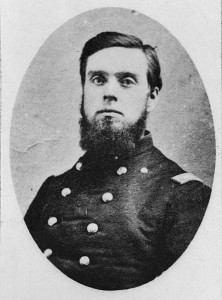I have just returned from a business trip in California and can now resume the story of our Civil War ancestor Salathiel Timmons – I feel like I left everyone hanging!
As we learned in the last post, Salathiel’s regiment spent the winter of 1862-1863 protecting Union supply trains in Tennessee. In March of 1863, Salathiel’s regiment showed outstanding courage at the Battle of Vaught’s Hill and caught the attention of Colonel John T. Wilder, who asked the 123rd Illinois to accompany his Brigade on an eight-day expedition in early April, 1863.

Colonel Wilder was a smart and innovative man. In early 1863, Wilder had a crazy idea – he wanted to get horses for his infantry units. Not to form them into a Cavalry unit (soldiers that fought on horseback), but as a means to transport them to the battle lines more quickly. He also wanted to give his men the latest and greatest technology – repeating rifles instead of single-shot muzzle loaders. He presented his ideas to General Rosecrans. The General gave approval in February 1863 to form a mounted Brigade, even though the higher-ups in the War Department said, “Mounted Infantry are neither good infantry nor good cavalry”. The War Department was also wary of the new technology and did not approve to fund the guns. So Wilder arranged to finance the purchase under his personal credit. He intended to ask the infantrymen to buy the guns themselves. If a soldier could not afford to buy the gun with his own money, Col. Wilder co-signed a loan to be repaid out of the soldier’s pay. Each Spencer Repeating Rifle cost $35 – the equivalent of three months of pay.
All this innovation was scary to Wilder’s commanding officers. Even though he had the General’s permission, Wilder was not authorized to coerce the regiments in his existing Brigade to stay. Each regiment was able to take a vote – they had to agree to become mounted infantry, and they had to agree buy their own rifles.
Of Wilder’s original four Regiments, three of them voted to stay in the Brigade: the 17th Indiana, the 72nd Indiana and the 98th Illinois. The fourth regiment, the 75th Indiana, voted down the proposal. So Wilder had to find a replacement regiment. He recalled how well the 123rd Illinois performed on the earlier expedition and invited them to join. On May 6, 1863, the Regiment took a vote and decided to join Wilder’s Brigade. A fifth regiment, the 92nd Illinois, joined a while later. The last piece of the puzzle was to find an artillery unit, and he was able to convince the 18th Indiana Battery to join. They had six 3-inch Rodman guns and were led by Captain Eli Lilly. If that name is familiar to you, yes, this is the same Eli Lilly that founded a pharmaceutical company after the war, a company that still exists to this day.
Wilder couldn’t wait for the requisitioned horses to arrive, so he had his men go out on raids in the Tennessee countryside, commandeering the the horses they needed.
Everything was now set, and the Brigade set out on a month-long crash course in learning how to handle their horses and shoot their new Spencer Repeating Rifles.
What might have been an exciting time for the Timmons brothers was soon tainted by tragedy. The youngest of the brothers, Battle, fell ill and died on May 8, 1863, just two days after their Regiment joined Wilder’s Brigade. According to family legend, he died of illness – probably dysentery or typhoid which were rampant in the camps at that time.
____
I have uncovered more information about the 123rd Illinois and the Wilder’s Brigade than I could possibly relay to you in this blog. I will continue to describe the highlights of Salathiel’s Civil War experiences, but some of you may wish to dig a little deeper. Here are some resources for you:
- A 2012 New York Times article about Wilder’s Brigade
- A PDF document describing a Spencer Repeating Rifle from the 123rd Illinois, on display in a museum in Wisconsin
And finally, I must tell you about an amazing book that you can buy for only $3.99 if you have a Kindle or iPad. It’s called “Morning to Midnight in the Saddle: Civil War Letters of a Soldier in Wilder’s Lightning Brigade” by Christopher D. McManus et al (printed versions are available as well). This is a self-published book that three cousins wrote about an ancestor who served in Company K of the 123rd Illinois. The book contains over 100 letters written during the war, and describes the actions of the 123rd Illinois in detail. The Timmons brothers are even mentioned in the book! I have no doubt that the Timmons brothers were acquainted with Otho McManus, the subject of this book. If you really want to know what Salathiel’s Civil War experience was like, I highly recommend this book; it is extremely well-written and well-researched.
